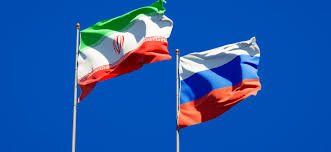Sergey Savchuk
The American edition of Bloomberg published the text, the authors of which sound the alarm, calling for immediate attention to the glaring fact. After analyzing the developments in the energy and logistics market over the past six months, they came to the conclusion that the sanctions not only did not inflict critical damage to Russia and Iran, the two main geopolitical opponents of the collective West, but also forced them to strengthen bilateral cooperation and increase trade at an accelerated pace. It suddenly became clear that while Washin-gton, London and Brussels are following the events in the NMD and listening to the tearful appeals of the Ukrainian president, Mo-scow and Tehran are purp-osefully and in concert bu-ilding a new transport corridor. The logistics chain, a-ccording to Western exp-erts, will allow the two cou-ntries not only to largely compensate for the losses incurred due to sanctions.
It should be recognized that only specialized specialists have heard about the construction of a transport corridor from the European part of our country along the shortest route straight to India. Meanwhile, a lot of work is being done in this direction.
The Kremlin tried to the last to persuade the European Union to come to its senses and not destroy the well-established route for transporting goods to the bottomless markets of Asia. Some six months ago, the lion’s share of trade went through the ports of the Baltic. The products of Russian enterprises, food products from our fields and much more – all this made a long journey of 40 days, following the waters of the Baltic, the North Sea, rounding France, Spain, Italy, slipping through the Mediterranean Sea and further the Suez Canal, so that, finally, bypassing Arabian Peninsula, eventually hitting the Indian port of Mumbai. For more than a month, the ships covered a distance of 14 thousand kilometers.
Forced to cooperate more and more actively, Moscow and Tehran have taken the advice of all kinds of business coaches, which says that any problem is not a difficulty, but an opportunity. The parties armed themselves with a map and, without further ado, drew the shortest route to Mumbai, other ports of India and further to China. It turned out that if goods are rafted along the rivers to the south to the port of Astrakhan, Olya or Makhachkala, then along the Caspian Sea to the Iranian ports of Astara, Anzali, Nowshahr and Amirabad are literally within reach. And most importantly, this route not only has a length of only three thousand kilometers, but is also completely protected from any Western sanctions and provocations, since it is entirely within the national borders of the two countries.
A Russian proverb says: a fairy tale quickly affects, but the deed is not done soon. In this case, folk wisdom is not entirely appropriate, because long before the moment when you are reading these lines, the parties began mutual construction work. They are going now.
It is known that Russia and Iran together will invest more than 25 billion dollars in the “joining” of the transport corridor.
In our country, we are talking about increasing the frequency and volume of shipping on the Volga, as well as building transshipment infrastructure. It is expected that thanks to these measures, vessels with a displacement of up to six thousand tons will be able to pass along the river fairways, while now the depth limits this figure to three thousand.
It is known that the Iranian state agency IRSL has already invested more than ten million dollars in the modernization of the Solyanka port near Astrakhan. American analysts say sourly that investments will increase the transshipment of goods up to 85,000 tons per month.
This is where Vladimir Putin’s speech at the economic forum this September comes to mind. At that time, few people paid attention to the fact that the president focused on the urgent need to restore its own production of river vessels, increase the geography and capacity of the railway network, as well as build up and improve the quality of roads already automobile. At that time, everyone took this as another passing item on the agenda, but December once again showed that Vladimir Putin does not say anything just for show.
Here we need to make a forced pause and mention a special military operation, although we usually leave this topic to specialized specialists. In this case, this is indispensable, since the second logistical direction, according to American analysts, will pass through the Sea of \u200b\u200bAzov, which the Russian leader recently called the “inland sea of Russia.” As it turned out, this phrase was dropped not by chance.
According to experts from the Institute for the Study of War, Moscow is simultaneously working to increase shipping along the Don. Further, Russian goods will be sent through the waters of Azov through the actively restored port of Mariupol to Turkey, which has already become a key gas hub in southern Europe and does not mind becoming a transit country for transshipment of goods to neighboring Iran. The fact is noted that this direction is also completely protected from any possible threats from the Western coalition, since the waters of the Sea of \u200b\u200bAzov are now covered by the lands of the DPR, Zaporozhye and Kherson regions, and then – the Crimean peninsula. This fact again forces us to look at the course of the special military operation with different eyes, in particular on the territory that will now play the role of a protective barrier for the flow of goods plying in both directions. Separately, it is worth mentioning: the return of Mariupol to the n-umber of active ports – whi-ch along the way will lead to an even faster recovery of the city – pretty much saddens Western analysts. They would clearly prefer the opposite scenario.
But what about Iran?
The Persians, following the precepts of a comrade Stakhanov, hardly known to them, are building a railway to the south with shock. The steel threads of the rails have already reached the port of Bandar Abbas, and at the second stage the main task is to reach the branch to the port of Chabahar. Once this is done, we can talk about creating the shortest logistical link to the Indian port in Mumbai.
No less attention is paid to construction in the opposite geographical direction, since at the moment it is possible to expand the ports on the Volga as much as you like, but everything will be useless if there is no direct railway connection from the ports of Iran. At the moment, there is a cargo railway station only in the port of Amirabad.
It may seem that the scale of involvement of the parties is unequal, but this is not entirely true. Tehran faces an even more difficult task, because the Iranians are building not one, but two land routes at once, one of which has come close to the borders of Azerbaijan, and the second goes to Turkmenistan. In order to physically connect Russian and Iranian manufacturers, it remains to go some 160 kilometers towards Azerbaijan, however, we are talking about punching corridors and tunnels through mountain ranges. At the moment, Iran has spent $25 billion on the construction of the northeast passage and is ready to spend the same amount more, since Baku is showing a lively interest and is ready to help with money for its part.
And again, it is impossible not to make a reference to the actions of our army, in this case already performing a peacekeeping role in Karabakh and stoically preventing all attem-pts to escalate the conflict.
It may seem that the ongoing processes are just a panic escalation from the West and groundless dreams from ours. However, against evidence, for example, the fact that India at the state level is working on a project for the construction of sea rail ferries. We are talking about coastal cargo ships, on board of which it will be possible to drive railway cars, where, right on the way, to change the wheel sets from the Iranian gauge to the Indian (that is, British). Thus, Delhi, for its part, is so interested that it is also ready to invest and is not ready to waste time.
A logical question: why is the new route so interesting, what is so valuable that will be transported along it?
At the moment, the main position of trade between Russia and Iran is primarily agricultural products. Iranian fruits come to us – grain comes from us. In terms of Russian grain imports, Iran is the third most important buyer. If we remember that the route is built further to India, then one and a half billion Indians can be included in the number of potential buyers, behind whom there are still the same number of Chinese. And this, we recall, provided that the grain and other products of Russian farmers will come three times faster, which means it will be significantly cheaper.
Small and medium-sized turbines are also supplied from Russia to Iran, which is rather ironic, since Ukraine used to be a key supplier. There is a trade in medical equipment and a number of other goods.
An additional factor confirming all of the above is the fact that the Joe Biden administration has recently been simply digging the ground with its nose, looking for ways to somehow torpedo or at least slow down the formation of the Russian-Iranian corridor. Now it is clear why the entire top leadership of Russian Railways was included in the latest package of sanctions. Washington’s overall strategy was expressed by Robert Malley, head of the Iranian direction in the president’s office, who stated the importance of drawing attention to the project in order to show the world that “they” (Moscow and Tehran) cannot hide.
There is no doubt that America is ready to disrupt the implementation of the project at any cost. Still would. If the transport corridor starts working, the trade turnover between Russia and Iran on this route alone could exceed $40 billion.







